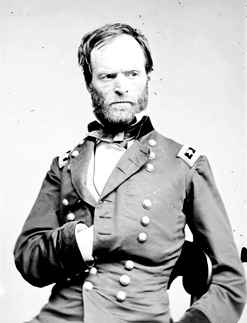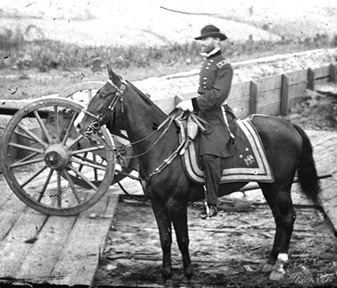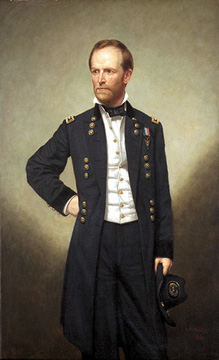
|
Sherman was born on February 8, 1820, in Lancaster,
Ohio, and educated at the U.S. Military Academy. After an undistinguished
military career he resigned from the army in 1853 to become a
partner in a banking firm in San Francisco. He was president
of a military college in Alexandria, Louisiana (now Louisiana
State University) from 1859 to the beginning of 1861, when Louisiana
seceded from the Union. |
|
At the outbreak of the Civil War in 1861, he offered
his services to the Union Army and was put in command of a volunteer
infantry regiment, becoming a brigadier general of volunteers
after the First Battle of Bull Run.
Sherman led a division at the Battle of Shiloh on April 6 and
7, 1862, and was rewarded for his part in the victory by being
promoted to major general of volunteers. In December of that
year he failed in an attempt to seize the Confederate stronghold
of Vicksburg, on the Mississippi River, but in 1863 he fought
under General Ulysses S. Grant in the
campaign that ended in the capture of that city in July. He was
given command of the Army of Tennessee in the fall of 1863 and
fought in the Battle of Chattanooga.

|
In 1864 Sherman was made supreme commander of
the armies in the West and was ordered to move against Atlanta,
Georgia. During the opening months of the campaign, he lost the
Battle of Kennesaw Mountain, and he did not capture Atlanta until
almost three months later, on September 1. |
|
After ordering the burning of the military resources
of the city, he launched his most celebrated military action,
known as "Sherman's March to the Sea," in which, with
about 60,000 picked men, he marched from Atlanta to Savannah,
Georgia, on the Atlantic coast.
After reaching Savannah, Sherman next set out to join
forces with Grant in Virginia by marching from Georgia up through
North and South Carolina. During Sherman's march, the Northern
soldiers pillaged the areas they passed through demolishing military
resources along with houses, farms, and railroads.

|
Destruction was especially severe in South Carolina
because Union soldiers blamed the state for starting the war.
In February 1865 Columbia, the capital of South Carolina, was
burned to the ground, although the origins of the fire are unknown.
Sherman hoped that the destruction of his march would
lower Southern morale and help end the war. |
|
After three months of fighting, Sherman reached Raleigh,
North Carolina, and was prepared to continue north to Virginia.
However, the war came to an end. Following the surrender of Confederate
General Robert E. Lee to Grant on April
9, the Confederate army confronting Sherman surrendered to him
at Durham Station on April 26, 1865.
After the war Sherman was commissioned lieutenant
general in the regular army and, following Grant's election to
the presidency, he was promoted to the rank of full general on
March 4, 1869 and given command of the entire U.S. Army.

|
In 1865, shortly after the war ended, Mathew
Brady offered to photograph William Tecumseh Sherman along
with all of his generals (above). According to Brady, Sherman
doubted that his staff would remain in Washington for the picture,
but with characteristic energy the photographer appointed an
hour and notified all seven men (Oliver Otis Howard, John A.
Logan, William B. Hazen, Jefferson C. Davis, Henry Warner Slocum,
Joseph A. Mower, and Francis P. Blair). Blair alone missed the
sitting, and he is missing from the first set of photographs,
as shown here. But Brady arranged to photograph him separately
and added him to later versions of the portrait by pasting Blair's
image onto an existing photograph, exhibited here for the first
time. Brady then photographed the new, complete picture in order
to make a negative that recorded Sherman's entire staff, and
used it to print many copies of Sherman and His Generals. |
General Sherman published his "Memoirs"
in 1875 and retired in 1883. The famous phrase "war is hell"
is attributed to Sherman. |
![]()

